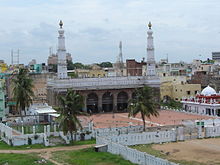Triplicane Big Mosque
| Triplicane Big Mosque | |
|---|---|
Wallajah Mosque | |
 A panoramic view of Biq Mosque; Dome, water tank and the two minarets | |
| Religion | |
| Affiliation | Islam |
| Location | |
| Location | Triplicane, Chennai, Tamil Nadu, India |
| Administration | Arcot Endowments Trust |
| Geographic coordinates | 13°04′N 80°16′E / 13.06°N 80.27°E |
| Architecture | |
| Type | Mosque |
| Style | Mughal |
| Completed | 1795 |
| Specifications | |
| Dome(s) | 2 (gold plated) |
| Minaret(s) | 2 |
| Minaret height | 131 ft (40 m) (tallest) |
Triplicane Big Mosque (also called Wallajah Mosque) is a mosque located in Triplicane High Road,
The Nawab of Arcot was friendly towards fellow Hindus, appointing a Hindu as his chief personal secretary. A chronogram written in Persian by Raja Makhhan Lal Bahdur Khirat, the Hindu Munshi of the Nawab, is found on the entrance to the prayer hall. The mosque is the largest and one of the oldest in Chennai and is active as a place of worship. It is administered by Prince of Arcot Endowments Trust. Most of the administrative staff of the mosque are Hindus, symbolizing peaceful coexistence between the two religions.
History

The
Architecture

Big Mosque is the largest mosque located in Chennai from the time of its establishment.[5] It is constructed of granite without any iron or wooden additions. There is no fixed architectural style, though the two minarets are characteristic of Mughal architecture. Historians attribute the change of architecture to the arrival of North Indian Muslims who settled there. The mosque houses the image of the Persian scholar Barool. It is believed that he came from Lucknow to educate the royal family.[2] The chronogram written by Raja Makhhan Lal Bahdur Khirat, the Munshi of the Nawab, is found on the entrance of the prayer hall. There is a large temple tank to the north east of the sanctum and a large ground in front of it. Almost the entire portion of the mosque has an equivalent width of steps leading to it. To the west of the sanctum, the mausoleums of important people associated with the royal family are located.[3]
Culture
Big Mosque is the largest and considered the principal mosque in the city of Chennai.[6] The mosque is an active place of worship. There is a constant flow of visitors in the mosque as it is located in one of the busiest places in Chennai.[7] The mosque can accommodate thousands of devotees. During the sacred festivals of Bakrid and Ramzan, the devotees overflow, some of them offering prayers from the surrounding grounds. There was a proposal made by the administration to cover the open grounds at least during festive occasions to protect devotees from inclement weather conditions. There were contrasting views put forth by heritage enthusiasts who argued against roofing claiming the openness and the architecture would be hidden by the structure.[8] The grave of Qaid-e-Millat M. Muhammad Ismail Sahib is situated in front of the mosque.[9]
References
- ISBN 9788190363426.
- ^ a b John, Ekatha Ann (17 January 2014). "Triplicane Big Mosque: Prayer calls to the past". TNN. The Times of India. Retrieved 23 November 2015.
- ^ ISBN 9788183794688.
- ^ Kannan, Ramya (12 August 2007). "Links with a royal past". The Hindu. Retrieved 23 November 2015.
- ISBN 9781136198335.
- ISBN 9781884964046.
- ^ Muthalaly, Shonali; Paitandy, Priyadarshini (25 August 2015). "Triplicane Big Mosque: Prayer calls to the past". The Hindu. Retrieved 23 November 2015.
- ^ S., Muthiah (9 October 2011). "Building in one heritage precinct". The Hindu. Retrieved 23 November 2015.
- ^ https://www.thehindu.com/society/history-and-culture/who-was-quaid-e-millat/article18347247.ece

